Preliminary Dual-Satellite Observations of Atmospheric Gravity Waves in Airglow
Abstract
1. Introduction
2. Instrumentation
3. AGW Observations
4. Discussions and Conclusion
5. Declarations
Availability of Data and Material
Author Contributions
Funding
Acknowledgments
Conflicts of Interest
References
- Holton, J.R. An Introduction to Dynamic Meteorology, 3rd ed.; Academic Press: San Diego, CA, USA, 1992; p. 511. [Google Scholar]
- Nappo, C. An Introduction to Atmospheric Gravity Waves; Academic Press: Cambridge, MA, USA, 2002. [Google Scholar]
- Fritts, D.C.; Alexander, M.J. Gravity wave dynamics and effects in the middle atmosphere. Rev. Geophys. 2003, 41, 1. [Google Scholar] [CrossRef]
- Lindzen, R.S. Turbulence and stress owing to gravity wave and tidal breakdown. J. Geophys. Res. 1981, 86, 9707–9714. [Google Scholar] [CrossRef]
- Holton, J.R. The Role of Gravity Wave Induced Drag and Diffusion in the Momentum Budget of the Mesosphere. J. Atmos. Sci. 1982, 39, 791–799. [Google Scholar] [CrossRef]
- Holton, J.R. The influence of gravity wave breaking on the general circulation of the middle atmosphere. J. Atmos. Sci. 1983, 40, 2497–2507. [Google Scholar] [CrossRef]
- Qian, L.; Burns, A.; Yue, J. Evidence of the lower thermospheric winter-to-summer circulation from SABER CO2 observation. Geophys. Res. Lett. 2017, 44, 10,100–10,107. [Google Scholar] [CrossRef]
- Qian, L.; Solomon, S.C.; Kane, T.J. Seasonal variation of thermospheric density and composition. J. Geophys. Res. 2009, 114, A01312. [Google Scholar] [CrossRef]
- Qian, L.; Burns, A.G.; Solomon, S.C.; Wang, W. Annual/semiannual variation of the ionosphere. Geophys. Res. Lett. 2013, 40, 1928–1933. [Google Scholar] [CrossRef]
- Hines, C.O. Internal gravity waves at ionospheric heights. Can. J. Phys. 1960, 38, 1441–1481. [Google Scholar] [CrossRef]
- Vadas, S.L.; Liu, H. The Generation of Large-Scale Gravity Waves and Neutral Winds in the Thermosphere From the Dissipation of Convectively-Generated Gravity Waves. J. Geophys. Res. 2009, 114, A10310. [Google Scholar] [CrossRef]
- Azeem, I.; Yue, J.; Hoffmann, L.; Miller, S.D.; Straka, W.C., III; Crowley, G. Multi-sensor profiling of a concentric gravity wave event propagating from the troposphere to the ionosphere. Geophys. Res. Lett. 2015, 24, 7874–7880. [Google Scholar] [CrossRef]
- Vadas, S.L.; Becker, E. Numerical modeling of the Excitation, propagation, and dissipation of primary and secondary gravity waves during wintertime at McMurdo Station in the Antarctic. J. Geophys. Res. Atmos. 2018, 123, 9326–9369. [Google Scholar] [CrossRef]
- Meinel, A.B. OH emission bands in the spectrum of the night sky. Astrophys. J. 1950, 111, 555. [Google Scholar] [CrossRef]
- Chamberlain, J.W. Physics of the Aurora and Airglow; Academic Press: New York, NY, USA, 1961; p. 704. [Google Scholar]
- Ingham, M.F. The light of the night sky and the interplanetary medium. Rep. Prog. Phys. 1971, 34, 875–912. [Google Scholar] [CrossRef]
- Peterson, A.W. Airglow events visible to the naked eye. Appl. Opt. 1979, 18, 3390. [Google Scholar] [CrossRef] [PubMed]
- Peterson, A.W.; Kieffaber, L.M. Infrared photography of OH airglow structures. Nature 1973, 244, 92. [Google Scholar] [CrossRef]
- Krassovsky, V.I.; Kuzmin, K.I.; Piterskaya, N.A.; Semenov, A.I.; Shagaev, M.V.; Shefov, N.N.; Torloshelidze, T.I. Results of some airglow observations of internal gravitational waves. Planet. Space Sci. 1975, 23, 896. [Google Scholar] [CrossRef]
- Krassovsky, V.I.; Shagaev, V. On the nature of internal gravity waves observed from hydroxyl emission. Planet. Space Sci. 1977, 25, 200. [Google Scholar] [CrossRef]
- Freund, J.T.; Jacka, F. Structure in the 557.7 nm (OI) airglow. J. Atmos. Terr. Phys. 1979, 41, 25. [Google Scholar] [CrossRef]
- Armstrong, E.B. The association of visible airglow features with a gravity wave. J. Atmos. Terr. Phys. 1982, 44, 325. [Google Scholar] [CrossRef]
- Gavrilov, N.M.; Shved, G.M. Study of internal gravity waves in the lower thermosphere form observations of the nocturnal sky airglow [OI] 5577 A in Ashhabbad. Ann. Geophys. 1982, 38, 789. [Google Scholar]
- Hapgood, M.A.; Taylor, M.J. Analysis of airglow image data. Ann. Geophys. 1982, 38, 805. [Google Scholar]
- Taylor, M.J.; Hapgood, M.A.; Rothwell, P. Observations of gravity wave propagation in the OI (557.7 nm), Na (589.2 nm) and the near infra-red OH nightglow emissions. Planet Space Sci. 1987, 35, 413. [Google Scholar] [CrossRef]
- Wu, Q.; Killeen, T.L. Seasonal dependence of mesospheric gravity waves (<100 km) at Peach Mountain Observatory, Michigan. Geophys. Res. Lett. 1996, 23, 2211–2214. [Google Scholar] [CrossRef]
- Nakamura, T.; Higashikawa, A.; Tsuda, T.; Matsushita, Y. Seasonal variations of gravity wave structures in OH airglow with a CCD imager at Shigaraki. Earth Planets Space 1999, 51, 897–906. [Google Scholar] [CrossRef]
- Hecht, J.H.; Walterscheid, R.L.; Hickey, M.P.; Franke, S.J. Climatology and modeling of quasi-monochromatic atmospheric gravity waves observed over Urbana, Illinois. J. Geophys. Res. 2001, 106, 5181–5195. [Google Scholar] [CrossRef]
- Ejiri, M.K.; Shiokawa, K.; Ogawa, T.; Igarashi, K.; Nakamura, T.; Tsuda, T. Statistical study of short-period gravity waves in OH and OI nightglow images at two separated sites. J. Geophys. Res. 2003, 108, 4679. [Google Scholar] [CrossRef]
- Suzuki, S.; Shiokawa, K.; Hosokawa, K.; Nakamura, K.; Hocking, W.K. Statistical characteristics of polar cap mesospheric gravity waves observed by an all-sky airglow imager at Resolute Bay. Can. J. Geophys. Res. 2009, 114, A01311. [Google Scholar] [CrossRef]
- Nielsen, K.; Taylor, M.J.; Hibbins, R.E.; Jarvis, M.J. Climatology of short-period mesospheric gravity waves over Halley, Antarctica (76° S, 27° W). J. Atmos. Sol. Terr. Phys. 2009, 71, 991–1000. [Google Scholar] [CrossRef]
- Yue, J.; Nakamura, T.; She, C.-Y.; Weber, M.; Lyons, W.; Li, T. Seasonal and local time variability of ripples from airglow imager observations in US and Japan. Ann. Geophys. 2010, 28, 1401–1408. [Google Scholar] [CrossRef]
- Narayanan, V.L.; Gurubaran, S. Statistical characteristics of high frequency gravity waves observed by OH airglow imaging from Tirunelveli (8.7° N). J. Atmos. Sol. Terr. Phys. 2013, 92, 43–50. [Google Scholar] [CrossRef]
- Li, Q.; Xu, J.; Liu, X.; Yuan, W.; Chen, J. Characteristics of mesospheric gravity waves over the southeastern Tibetan Plateau region. J. Geophys. Res. Space Phys. 2016, 121, 9204–9221. [Google Scholar] [CrossRef]
- Taylor, M.J.; Hapgood, M.A. Identification of a thunderstorm as a source of short period gravity waves in the upper atmospheric night-glow emissions. Planet. Space Sci. 1988, 36, 975–985. [Google Scholar] [CrossRef]
- Sentman, D.D.; Wescott, E.M.; Picard, R.H.; Winick, J.R.; Nielsen, H.C.S.; Dewan, E.M.; Moudry, D.R.; Sabbas, F.T.S.; Heavner, M.J.; Morrill, J. Simultaneous observations of mesospheric gravity waves and sprites generated by a midwesterm thunderstorm. J. Atmos. Terr. Phys. 2003, 65, 537–550. [Google Scholar] [CrossRef]
- Suzuki, S.; Shiokawa, K.; Otsuka, Y.; Ogawa, T.; Nakamura, K.; Nakamura, T. A concentric gravity wave structure in the mesospheric airglow images. J. Geophys. Res. 2007, 112, D02102. [Google Scholar] [CrossRef]
- Yue, J.; Vadas, S.L.; She, C.-Y.; Nakamura, T.; Reising, S.C.; Liu, H.-L.; Stamus, P.; Krueger, D.A.; Lyons, W.; Li, T. Concentric gravity waves in the mesosphere generated by deep convective plumes in the lower atmosphere near Fort Collins, Colorado. J. Geophys. Res. 2009, 114, D06104. [Google Scholar] [CrossRef]
- Vadas, S.; Yue, J.; Nakamura, T. Mesospheric concentric gravity waves generated by multiple convection storms over the North America Great Plain. J. Geophys. Res. Atmos. 2012, 117, D07113. [Google Scholar] [CrossRef]
- Xu, J.; Li, Q.; Yue, J.; Hoffmann, L.; Straka, W.C., III; Wang, C.; Liu, M.; Yuan, W.; Han, S.; Miller, S.D.; et al. Concentric gravity waves over northern China observed by an airglow imager network and satellites. J. Geophys. Res. Atmos. 2015, 120, 11058–11078. [Google Scholar] [CrossRef]
- Smith, S.; Baumgardner, J.; Mendillo, M. Evidence of mesospheric gravity–waves generated by orographic forcing in the troposphere. Geophys. Res. Lett. 2009, 36, 8. [Google Scholar] [CrossRef]
- Suzuki, S.; Vadas, S.L.; Shiokawa, K.; Otsuka, Y.; Kawamura, S.; Murayama, Y. Typhoon-induced concentric airglow structures in the mesopause region. Geophys. Res. Lett. 2013, 40, 5983–5987. [Google Scholar] [CrossRef]
- Miller, S.D.; Straka, W., III; Mills, S.P.; Elvidge, C.D.; Lee, T.F.; Solbrig, J.; Walther, A.; Heidinger, A.K.; Weiss, S.C. Illuminating the capabilities of the Suomi NPP VIIRS Day/Night Band. Remote Sens. 2013, 5, 6717–6766. [Google Scholar] [CrossRef]
- Miller, S.D.; Mills, S.P.; Elvidge, C.D.; Lindsey, D.T.; Lee, T.F.; Hawkins, J.D. Suomi satellite brings to light a unique frontier of nighttime environmental sensing capabilities. Proc. Nat. Acad. Sci. USA 2012, 109, 15706–15711. [Google Scholar] [CrossRef] [PubMed]
- Miller, S.D.; Straka, W.C.; Yue, J.; Smith, S.M.; Alexander, M.J.; Hoffmann, L.; Setvak, M.; Partain, P.T. Upper atmospheric gravity wave details revealed in nightglow satellite imagery. Proc. Nat. Acad. Sci. USA 2015, 112, E6728–E6735. [Google Scholar] [CrossRef] [PubMed]
- Yue, J.; Miller, S.; Hoffmann, L.; Straka, W.C., III. Stratospheric and mesospheric concentric gravity waves over tropical cyclone Mahasen: Joint AIRS and VIIRS satellite observations. J. Atmos. Solar Terra. Phys. 2014, 119, 83–90. [Google Scholar] [CrossRef]
- Lai, C.; Yue, J.; Xu, J.; Straka, W.; Miller, S., III; Liu, X. Suomi NPP VIIRS/DNB imagery of nightglow gravity waves from various sources over China. Adv. Space Res. 2017, 59, 1951–1961. [Google Scholar] [CrossRef]
- Miller, S.D.; Straka, W., III; Yue, J.; Seaman, C.; Xu, S.; Elvidge, C.; Hoffmann, L.; Azeem, I. The Dark Side of Hurricane Matthew—Unique Perspectives from the Day/Night Band. Bull. Am. Meteorol. Soc. 2018, 99, 2561–2574. [Google Scholar] [CrossRef]
- Xu, S.; Yue, J.; Xue, X.; Vadas, S.; Miller, S.; Azeem, I.; Straka, W.; Hoffmann, L.; Zhang, S. Dynamical coupling between Hurricane Matthew and the Middle to Upper Atmosphere via gravity waves. J. Geophys. Res. Space 2019, 124. [Google Scholar] [CrossRef]
- Su, Y.; Yue, J.; Liu, X.; Miller, S.D.; Straka, W.C.; Smith, S.; Guo, D.; Guo, S. Mesospheric bore observations using Suomi NPP VIIRS DNB during 2013–2017. Remote Sens. 2018, 10, 1935. [Google Scholar] [CrossRef]
- Li, Q.; Xu, J.; Yue, J.; Liu, X.; Yuan, W. Evolution of a mesospheric bore in a duct observed by ground-based double-layer imagers and satellite observations over the Tibetan Plateau Region. J. Geophys. Res. Space 2019, 124, 1377–1388. [Google Scholar] [CrossRef]
- Sakanoi, T.; Akiya, Y.; Yamazaki, A.; Otsuka, Y.; Saito, A.; Yoshikawa, I. Imaging observation of the Earth’s mesosphere, thermosphere and ionosphere by VISI of ISS-IMAP on the international space station. IEEJ Trans. Fundam. Mat. 2011, 131, 983–988. [Google Scholar] [CrossRef]
- Akiya, Y.; Saito, A.; Sakanoi, T.; Hozumi, Y.; Yamazaki, A.; Otsuka, Y.; Nishioka, M.; Tsugawa, T. First spaceborne observation of the entire concentric airglow structure caused by tropospheric disturbance. Geophys. Res. Lett. 2014, 41, 6943–6948. [Google Scholar] [CrossRef]
- Perwitasari, S.; Sakanoi, T.; Yamazaki, A.; Otsuka, Y.; Hozumi, Y.; Akiya, Y.; Saito, A.; Shiokawa, K.; Kawamura, S. Coordinated airglow observations between IMAP/VISI and a ground-based all-sky imager on concentric gravity wave in the mesopause. J. Geophys. Res. Space Phys. 2015, 120, 9706–9721. [Google Scholar] [CrossRef]
- Perwitasari, S.; Sakanoi, T.; Nakamura, T.; Ejiri, M.K.; Tsutsumi, M.; Tomikawa, Y.; Otsuka, Y.; Yamazaki, A.; Saito, A. Three years of concentric gravity wave variability in the mesopause as observed by IMAP/VISI. Geophys. Res. Lett. 2016, 43, 11–528. [Google Scholar] [CrossRef]
- Hozumi, Y.; Saito, A.; Sakanoi, T.; Yamazaki, A.; Hosokawa, K. Mesospheric bores at southern midlatitudes observed by ISS-IMAP/VISI: A first report of an undulating wave front. Atmos. Chem. Phys. 2018, 18, 16399–16407. [Google Scholar] [CrossRef]
- Hozumi, Y.; Saito, A.; Sakanoi, T.; Yamazaki, A.; Hosokawa, K.; Nakamura, T. Geographical and seasonal variability of mesospheric bores observed from the International Space Station. J. Geophys. Res. Space Phys. 2019, 124, 3775–3785. [Google Scholar] [CrossRef]
- Alexander, M.J.; Holton, J.R.; Durran, D.R. The gravity wave response above deep convection in a squall line simulation. J. Atmos. Sci. 1995, 52, 2212–2226. [Google Scholar] [CrossRef]
- Bankert, R.L.; Solbrig, J.E.; Lee, T.F.; Miller, S.D. Automated lightning flash detection in nighttime visible satellite data. Weather Forecast. 2011, 26, 399–408. [Google Scholar] [CrossRef]
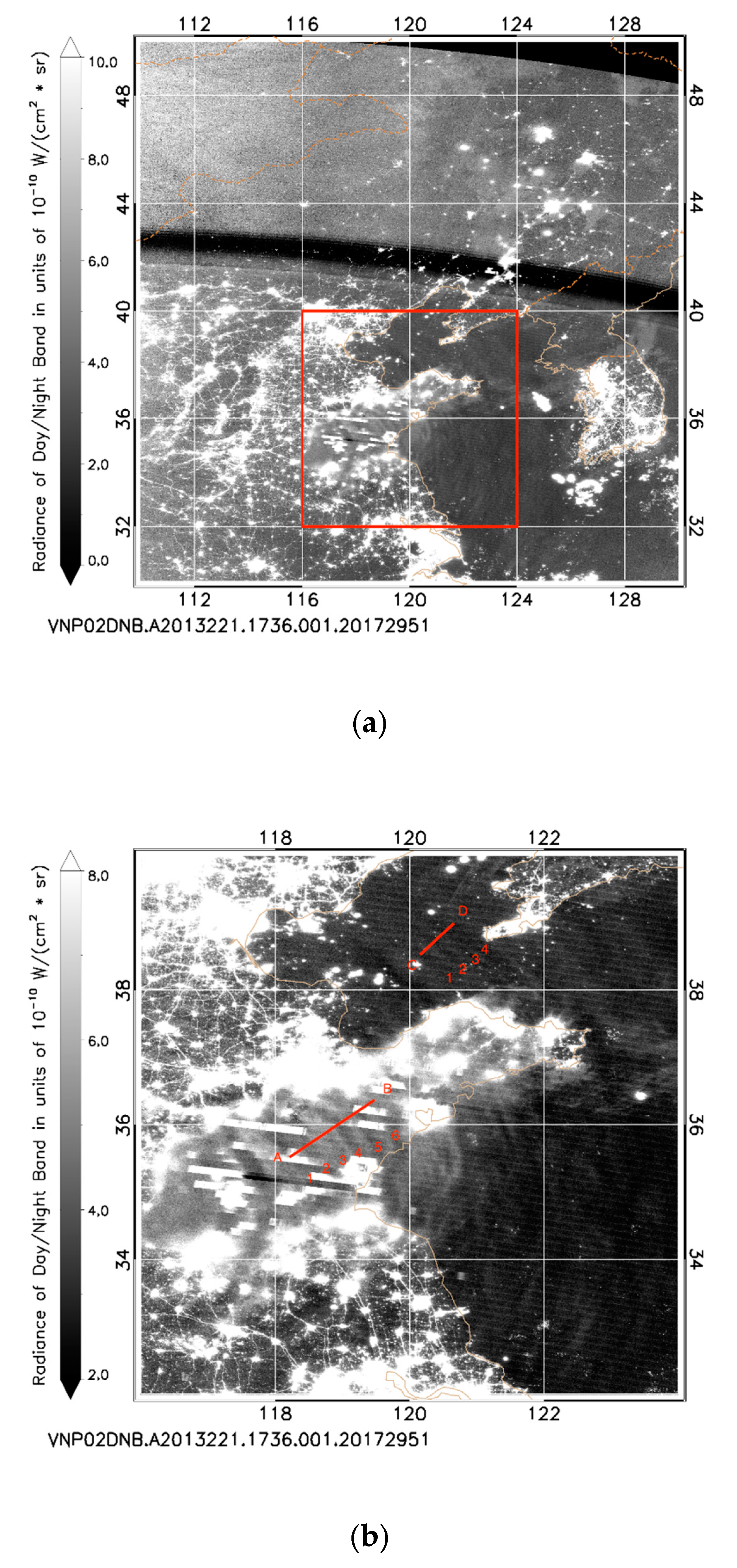
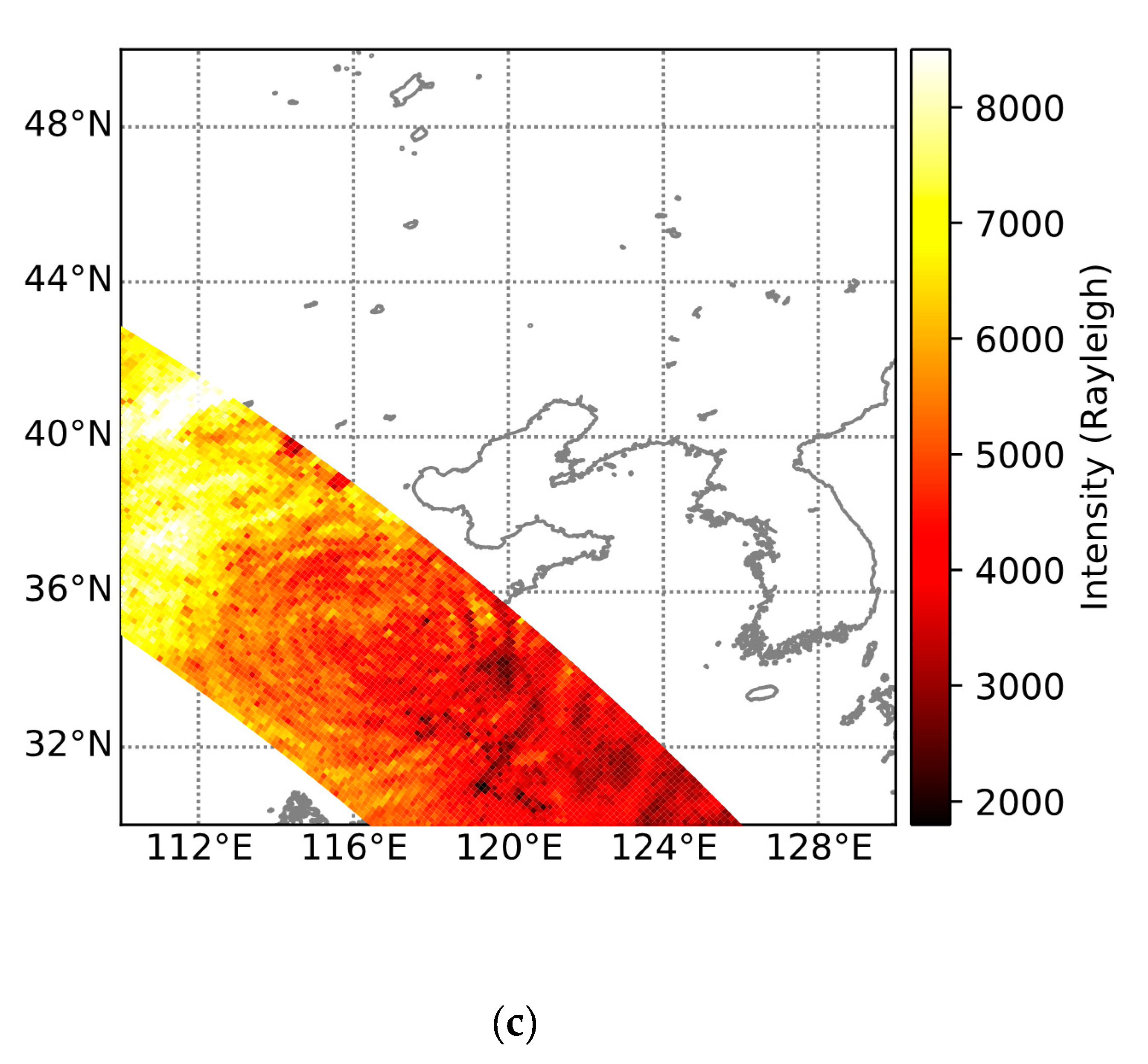
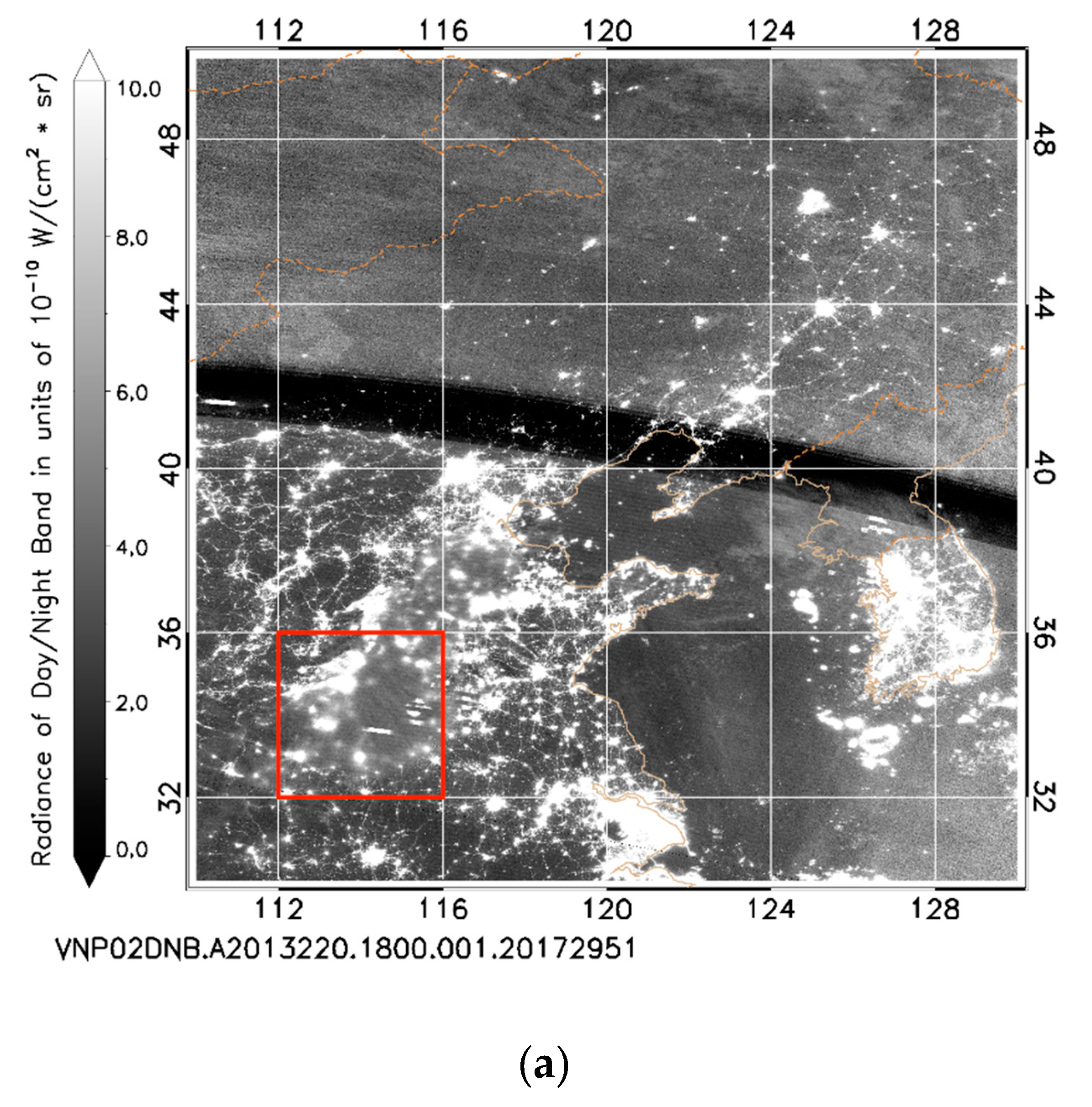
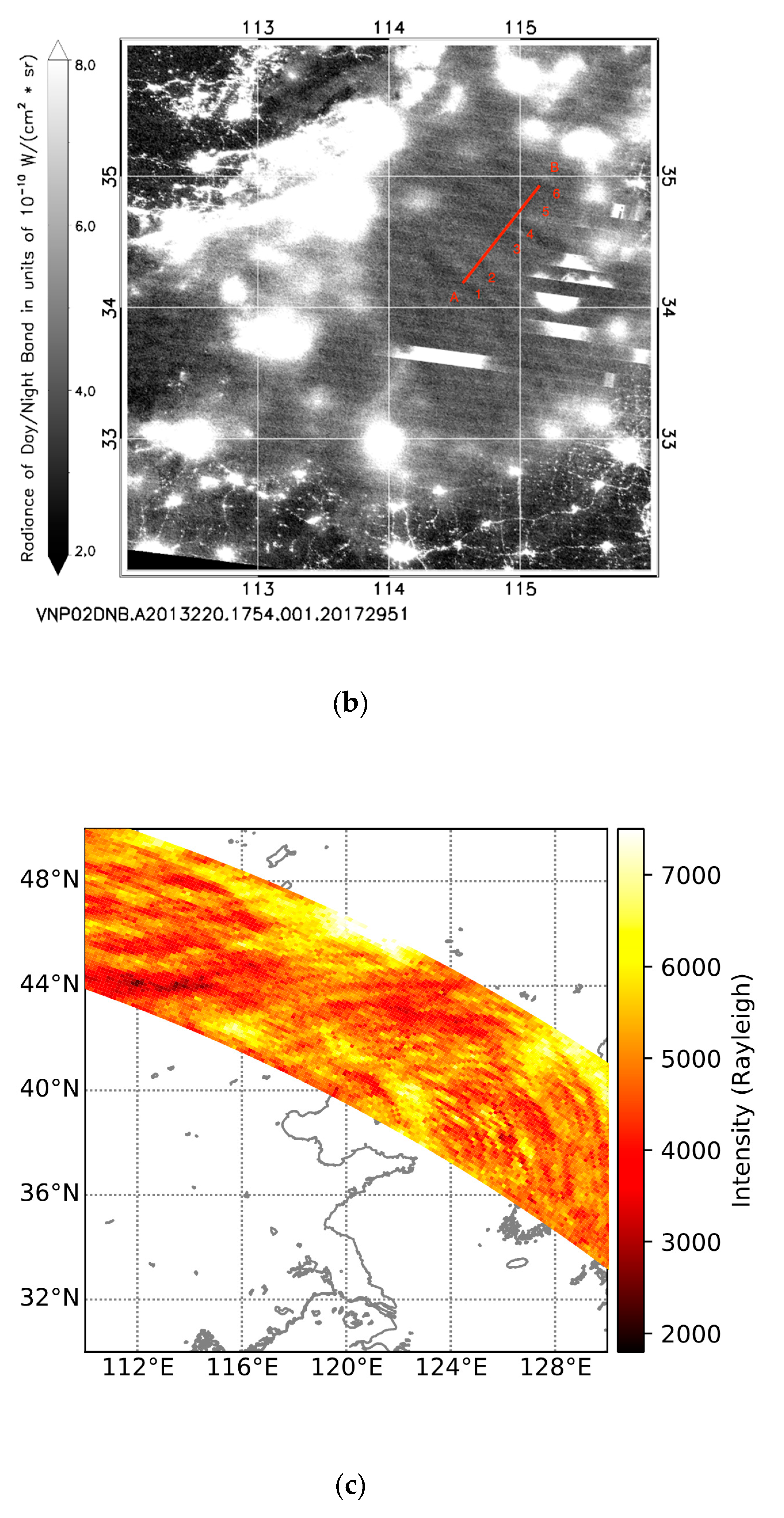
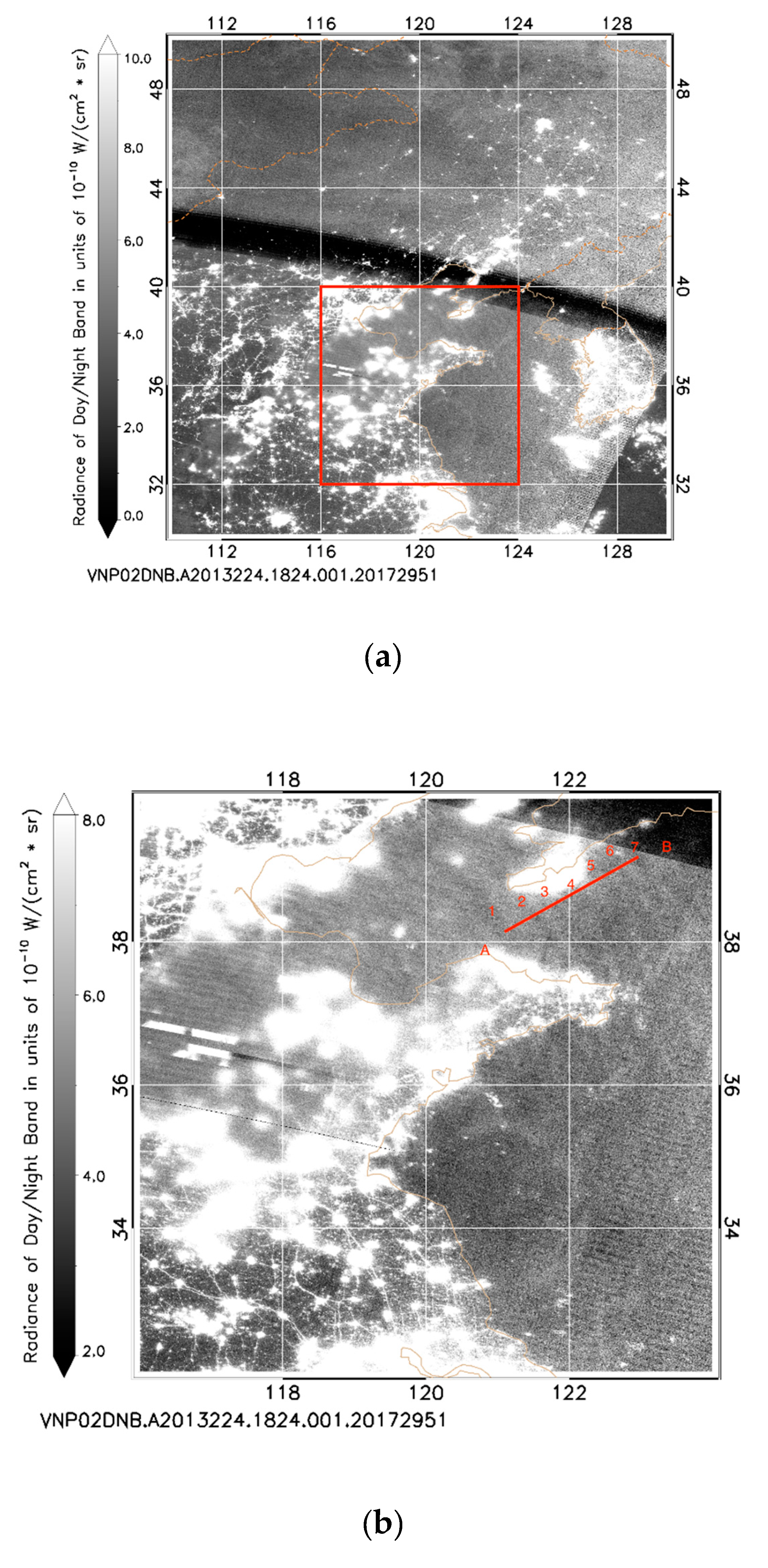
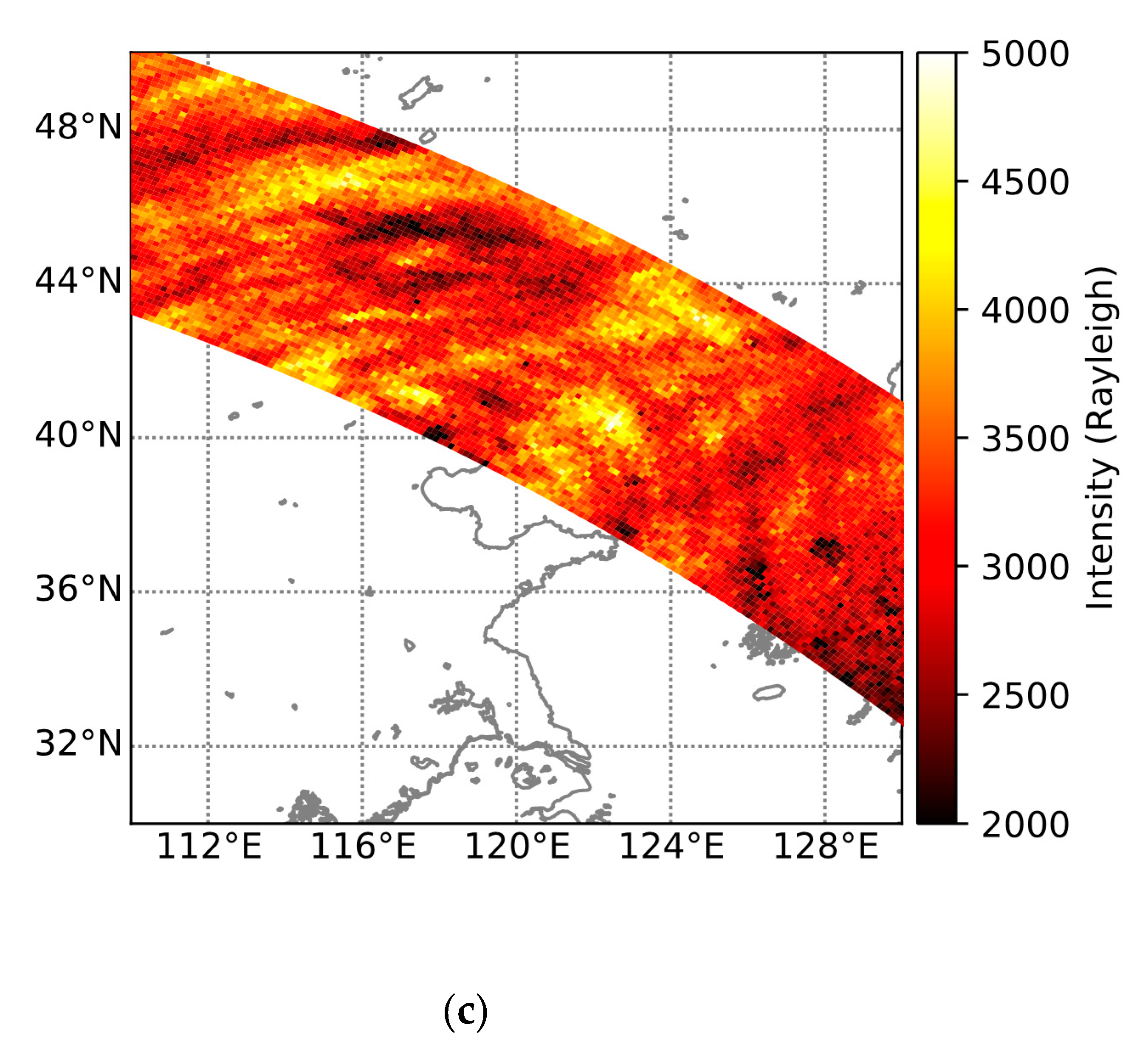
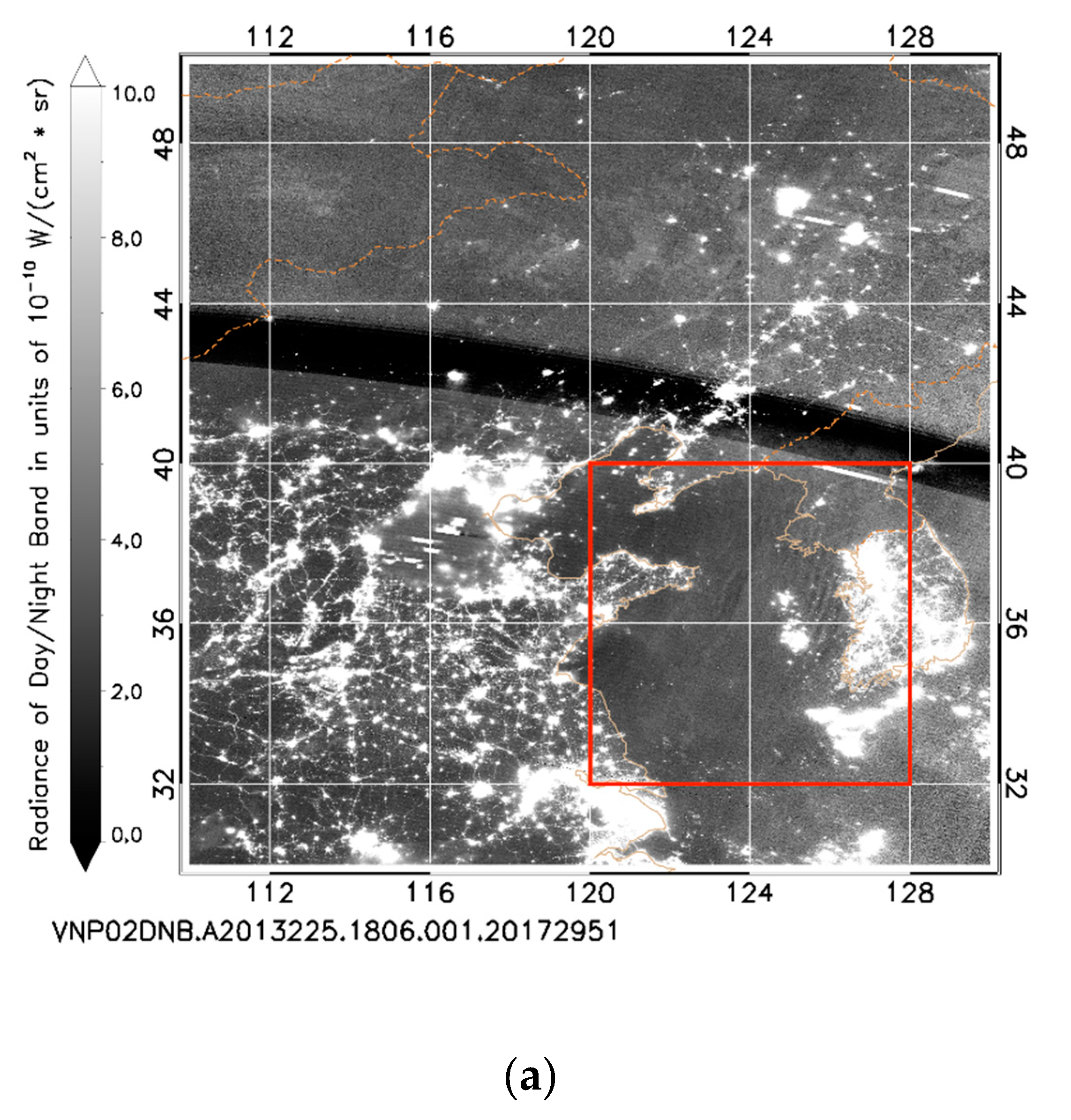

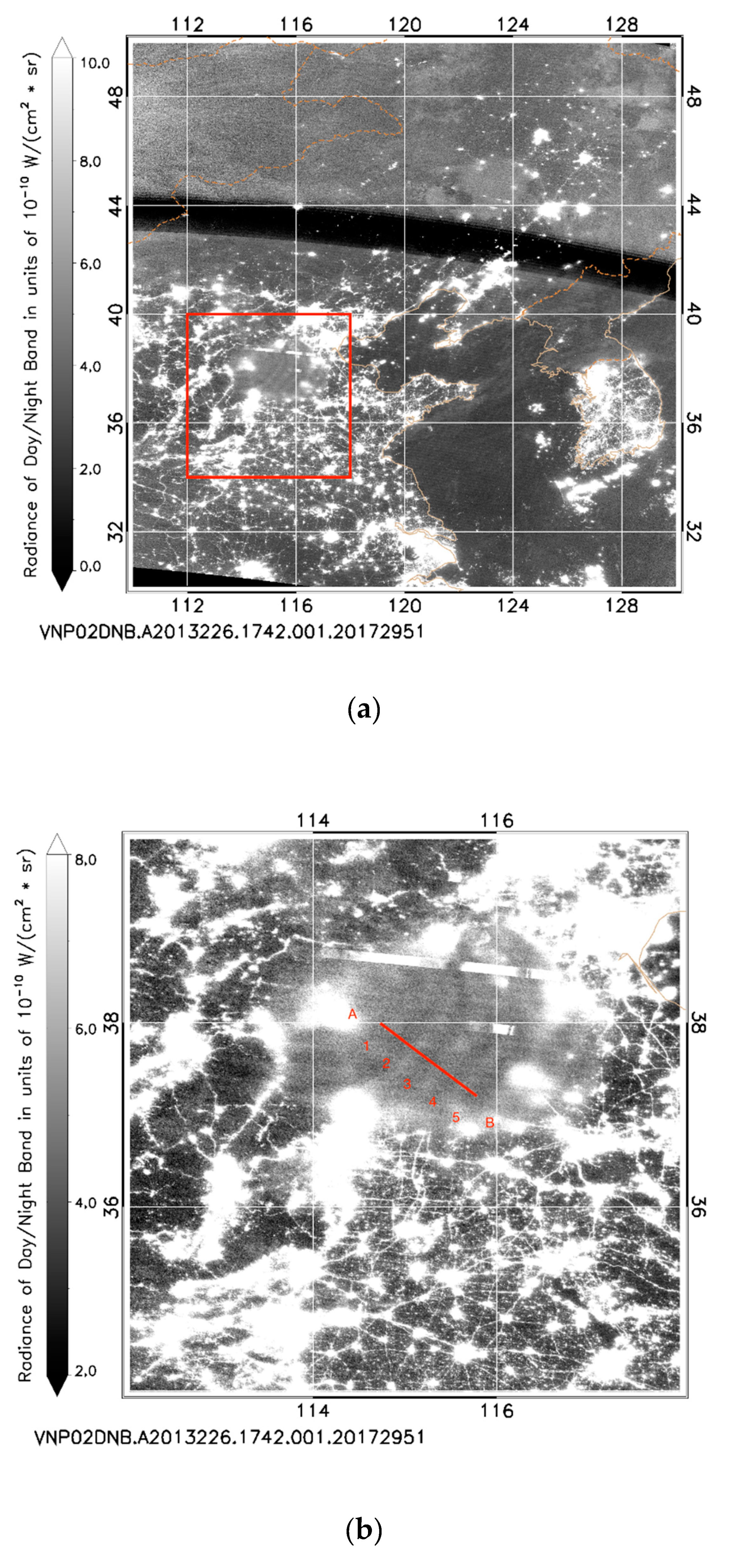
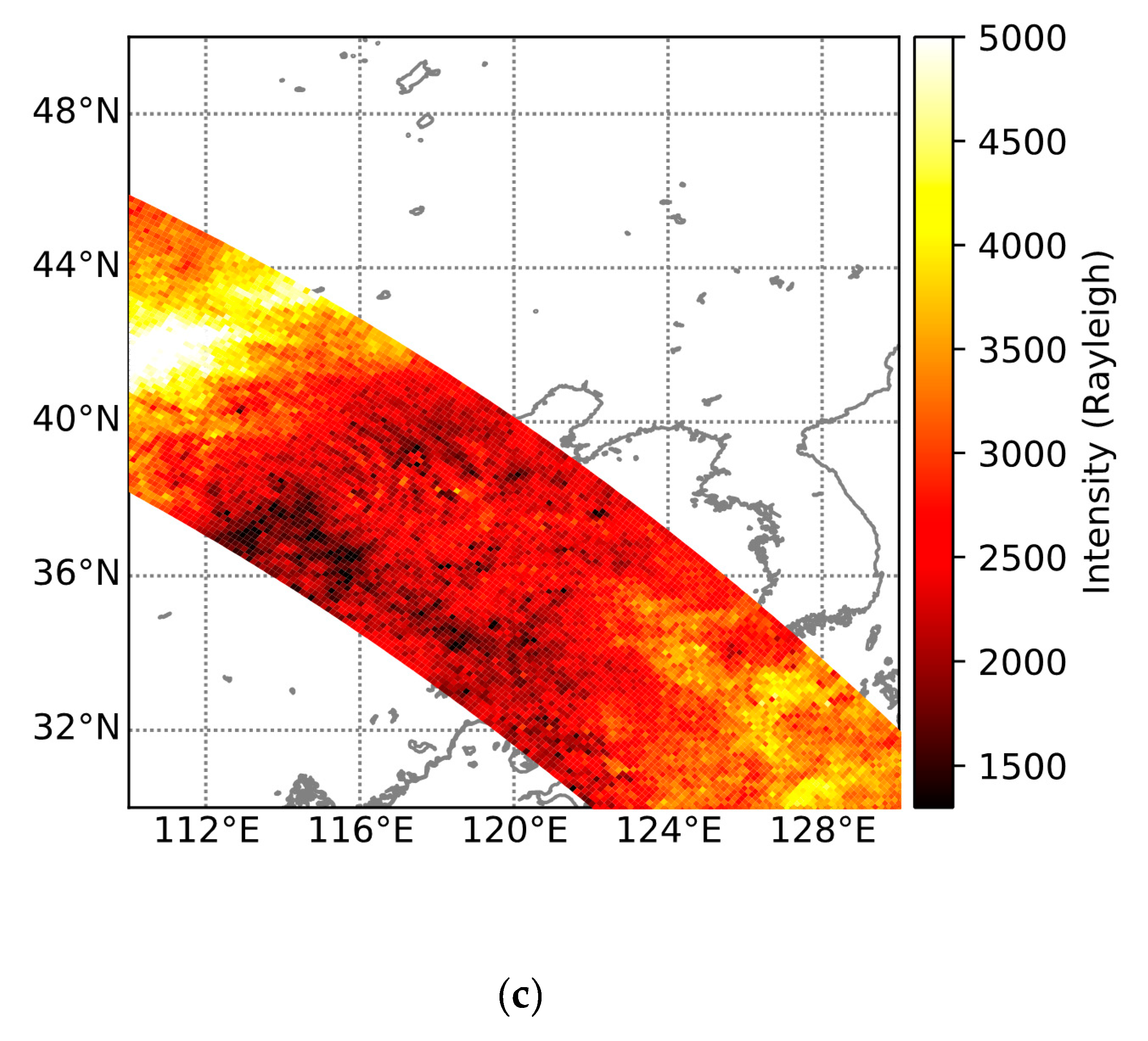
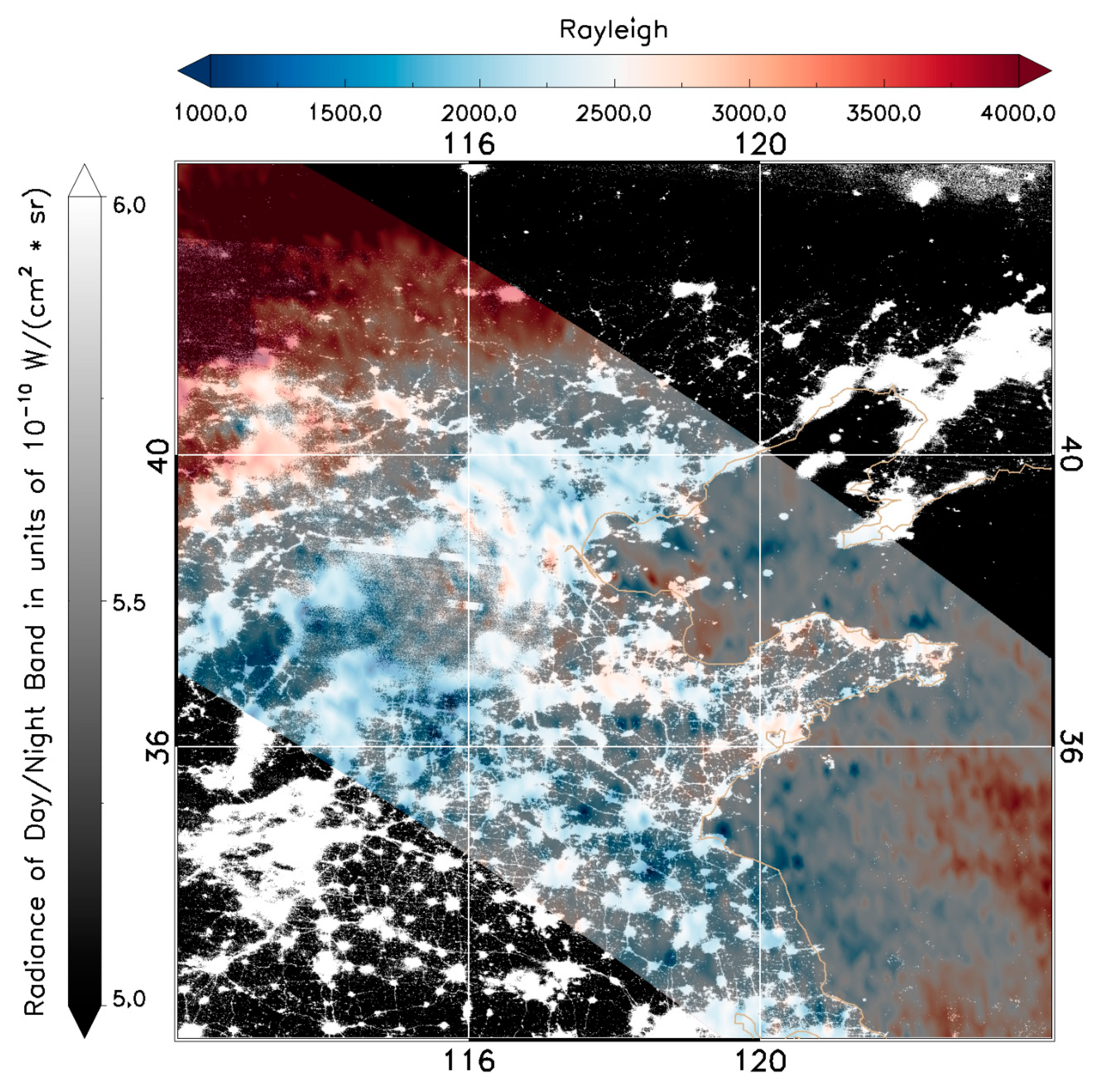
| Technique | Dates | Spectrum | Horizontal Resolution | Swath Width | Latitude Range | |
|---|---|---|---|---|---|---|
| VISI | Imaging spectrograph | 9/2012–8/2015 | 630–762 nm | 14–16 km | 600 km | 54° S–54° N |
| VIIRS/DNB | Radiometer | 11/2011–present | 505–890 nm | 0.75 km | 3000 km | 90° S–90° N |
| 8 August 2013 | 9 August 2013 | 12 August 2013 | 13 August 2013 | 14 August 2013 | |
|---|---|---|---|---|---|
| VISI | 40 km | 52 km | 68 km | 47 km | 53 km |
| DNB | 20 km | 22–30 km | 33 km | 22 km | 21 km |
© 2019 by the authors. Licensee MDPI, Basel, Switzerland. This article is an open access article distributed under the terms and conditions of the Creative Commons Attribution (CC BY) license (http://creativecommons.org/licenses/by/4.0/).
Share and Cite
Yue, J.; Perwitasari, S.; Xu, S.; Hozumi, Y.; Nakamura, T.; Sakanoi, T.; Saito, A.; Miller, S.D.; Straka, W.; Rong, P. Preliminary Dual-Satellite Observations of Atmospheric Gravity Waves in Airglow. Atmosphere 2019, 10, 650. https://doi.org/10.3390/atmos10110650
Yue J, Perwitasari S, Xu S, Hozumi Y, Nakamura T, Sakanoi T, Saito A, Miller SD, Straka W, Rong P. Preliminary Dual-Satellite Observations of Atmospheric Gravity Waves in Airglow. Atmosphere. 2019; 10(11):650. https://doi.org/10.3390/atmos10110650
Chicago/Turabian StyleYue, Jia, Septi Perwitasari, Shuang Xu, Yuta Hozumi, Takuji Nakamura, Takeshi Sakanoi, Akinori Saito, Steven D. Miller, William Straka, and Pingping Rong. 2019. "Preliminary Dual-Satellite Observations of Atmospheric Gravity Waves in Airglow" Atmosphere 10, no. 11: 650. https://doi.org/10.3390/atmos10110650
APA StyleYue, J., Perwitasari, S., Xu, S., Hozumi, Y., Nakamura, T., Sakanoi, T., Saito, A., Miller, S. D., Straka, W., & Rong, P. (2019). Preliminary Dual-Satellite Observations of Atmospheric Gravity Waves in Airglow. Atmosphere, 10(11), 650. https://doi.org/10.3390/atmos10110650






